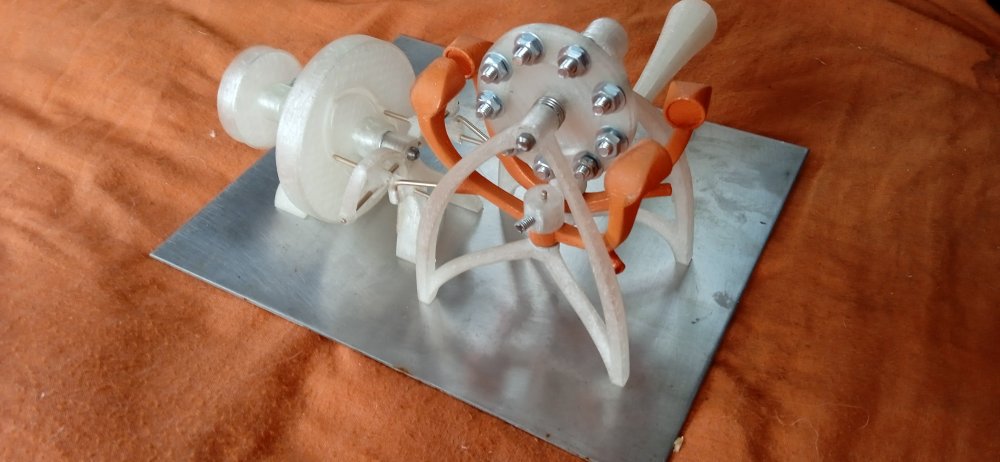All Activity
- Past hour
-
Not a field, just a wave function. The suggestion of time lapses is what I don't follow. To me, that makes no sense.
-
I went a bit off topic and was thinking about @joigus 's disginction btw reality and causality and probably got the wrong end of the stick. I think "realism" (local realism?) has a defined meaning and use in physics (quantum physics?) that I have not been able to get my head around so far and perhaps I confused it with "reality" As for the OP it seems there are time lapses that can be measured as well as distances but ,perhaps you are saying it that the field is in both places and it is just the measurements of two particles in that field that are separated by time and space giving the illusion that one particle travels to the position of the second particle -and at a speed above c.
-
LOL! It's interesting how much low value coinage gets thrown into lakes. I suppose people are seeing how many skips they can get a coin to do across the surface.
-
The mathematics and the rules to apply them are very precise. How to swallow the metaphysical pill is another matter. I was in the process of answering you when exchemist's answer blinked on my screen. I don't think it's about a subtle way of motion, or measuring "things" from a recent past, or something of the kind. I think it's about this beneath-reality physical variable that we call the probability amplitude. I carries energy and momentum and is coupled to currents. It's as physical as it can be. But it only gives you potentialities, what can happen, not what does happen.
- Today
-
No, I don't think thinking about passage of time is helpful. No change takes place - apart from the detection event that determines where the QM entity is. The problem here, it seems to me, is that what is called "tunnelling" is a rather misleading metaphor. There is no motion from inside to outside. The wave function of a QM entity will extend a bit on the far side of a potential barrier, if the barrier is narrow enough and low enough. So a detection event - which resolves the "probability cloud" into a definite position, may occasionally find the entity outside instead of inside.
-

Bias in science (split from Evolution of religiosity)
Luc Turpin replied to Luc Turpin's topic in Other Sciences
This is the additional information that I was able to gather as there is not much available on bias in science and the scientific materialistic dogma. It is mostly observational, but how many need to see Big Foot before it gets embarrassing to say that he absolutely does not exist. 1- A postmodern criticism of P.S. Churchland’s claims regarding materialism. The abstract of the article Modern Manifestations of Materialism: A Legacy of the Enlightenment Discourse states that: “Neurobiological explanations of behavior are used increasingly in the place of psychological explanations. This trend is indicative of the rise in popularity of materialism. " In order for Churchland to maintain her materialist position, she must assume a transparency in scientific method, an assumption which is a legacy of Enlightenment philosophy. However, many postmodern philosophers including M. Heidegger (1962, and 1977) and H. G. Gadamer (1995) have questioned this assumed transparency of method”. (PsycInfo Database Record (c) 2020 APA, all rights reserved https://psycnet.apa.org/record/1997-05471-004 2- From the abstract “Materialism and Selection Bias: Political Psychology from a Radical Constructivist Perspective” “Political psychology rests on the assumption of the existence of a world outside and independent of consciousness. This ontological materialism is hardly spoken of within the field, as it is an unchallenged assumption among most psychologists and social scientists, including political scientists. However, the materialist paradigm frames research designs, the interpretation of data and theory building.” “……the choice of a certain approach to answer a research question rests on the deeply ingrained beliefs of researchers” “These beliefs are usually not part of research presentations even though they have tremendous influence on the results of the whole research process. Recipients use these necessarily biased research results as building blocks for the construction of their own realities.” “….instead of coming closer to any kind of an “objective” understanding of political attitudes, in political psychology we cannot help but invent new stories about the (political) world as long as our beliefs consciously or unconsciously influence our decision making in theorizing and research practice.” “The article is a description of how a researcher’s subjective perception and construction of the (social) world has consequences for the complete research process. https://constructivist.info/16/3/327 3- Jon Mills on page 5 of a document titled “Five Dangers of Materialism” states the following: “Contemporary theories in cognitive science and the philosophy of mind lend burgeoning support to the materialist position regarding the mind-body problem. That is, naturalism, physicalism, and material monism are the preferred theories that explain the relationship between mental processes and physical brain states. Although dualist and spiritualist approaches offer counter arguments to materialism (Vender, 1994; Warner, 1994), the preponderance of current research in the philosophical, natural, and social sciences concludes that mental states are nothing but physical states (Armstrong, 1968; Bickle, 1998; Churchland, 1981, Dennet,1991; Dretske, 1995; Searle, 1994). From these accounts, mind is brain.” https://static1.squarespace.com/static/6077171f228eb219180f62e9/t/60a47c900f22b814725f6d73/1621392530260/Five+Dangers+of+Materialism.pdf 4- In “Beyond Scientific Materialism: Toward a Transcendent Theory of Consciousness”, author Barus Imants describes some of the pathways that may lead us beyond a materialistic worldview. I think that this will be cause for a lively debate with the physicists participating in our forum. “Analysis of the social-cognitive substrate of scientific activity reveals that much of science functions in an inauthentic mode whereby a materialist world view constrains the authentic practice of science. But materialism cannot explain matter, as evidenced by empirical data concerning the nature of physical manifestation. Nor, then, should materialism be the basis for our interpretation of consciousness. It is time to move beyond scientific materialism and develop transcendent theories of consciousness. Such theories should minimally meet the following criteria: they should be based on all of the usual empirical data concerning consciousness, including altered states of consciousness; they should take into account data about anomalous phenomena and transcendent states of consciousness; they should address the issue of existential meaning and provide soteriological guidance; and they should be consistent with the most accurate theories of physical manifestation, such as relativistic quantum field theories. Speculating within a quantum-theoretic context, consciousness could be inserted as a primitive element into reality by providing a role for intention in the selection process of observables, the collapse of the state vector, or the ordering of quantum fluctuations. But consciousness could be more fundamental, in the sense of a deep consciousness coinciding with a pre-physical substrate, from which intention shapes both mental experience and physical manifestation. If any significance can be attached to the mathematical formalism of relativistic quantum field theories, perhaps creation and annihilation operators, which determine the fluctuations of a quantum field, can metaphorically be regarded as the avenue through which intention acts. Morphic fields within the pre-physical substrate could hold in place patterns that shape the reality that we experience. Among such morphic fields could be ones that correspond to the world view of scientism. By becoming authentic, one could break from such constraints and consider alternative possibilities that can include various forms of radical transformation.” Author: Baruss, Imants Source: Journal of Consciousness Studies, Volume 17, Numbers 7-8, 2010, pp. 213-231(19) Publisher: Imprint Academic https://www.ingentaconnect.com/content/imp/jcs/2010/00000017/f0020007/art00012 5- On my contention that life cannot be reduced purely to the physical, Jesse M. Mulder in the abstract of “A Vital Challenge to Materialism” states that: “Life poses a threat to materialism. To understand the phenomena of animate nature, we make use of a teleological form of explanation that is peculiar to biology, of explanations in terms of what I call the ‘vital categories’ – and this holds even for accounts of underlying physico-chemical ‘mechanisms’. The materialist claims that this teleological form of explanation does not capture what is metaphysically fundamental, whereas her preferred physical form of explanation does. In this essay, I do three things. (1) I argue that the ‘vital categories’, such as life form and life-process, do not reduce to the ‘physical categories’ and show that there are no grounds for the materialist's metaphysically limiting claim; (2) I sketch a positive view on how vital and physical explanations can both apply to a given phenomenon, and on how they interrelate; and (3) I show that this view meshes nicely with evolutionary theory, despite being committed to a form of ‘biological essentialism’. Philosophy , Volume 91 , Issue 2 , April 2016 , pp. 153 - 18 https://www.cambridge.org/core/journals/philosophy/article/abs/vital-challenge-to-materialism/42296441632B6DC3FC77B61E5268E70C 6- A book preview of “A Skeptic’s Faith, Why Scientific Materialism Cannot be the Whole Truth” by Charles Siegel https://books.google.ca/books?hl=en&lr=&id=62ywEAAAQBAJ&oi=fnd&pg=PT5&dq=bias+science+materialism&ots=epLVizXaRC&sig=-fJXBYxQUkVgwqN_OhwDguUWtE4#v=onepage&q=bias%20science%20materialism&f=false 7-In “Notes Toward Stamping on the Corpse of Scientific Materialism” by Gary Allen states that: Science and its aura constitute the pervasive, unavoidable view and methodology of modernity. We cannot understand our era without considering its dominant presence. How we receive and convey information, transport our bodies, nourish ourselves, heal, fight our wars, the objects we possess and the clothes we wear, indeed, much of what we think bears its seal. We live within a paradigm that science--consciously or not--has generated. Accordingly, the accreted ideology of “scientific materialism” bounds and determines what is real and what is not, and shapes our perceptual universe. Science is a series of methods aimed at exploring the natural world and inventing useful tools. It generates a changing fabric of theories about the origin, nature, and functions of that world. It’s often animated by an open-ended spirit of inquisitiveness and delight in discovery. Unfortunately, science as the study of the natural world--sometimes for scientists and very much for modern global society--easily slips into scientific materialism, a theory that only the natural world truly exists. Rather than simply being “truth:’ it’s instead a dogma fabricated out of scientific data by its proponents that stands as the modern paradigm for reality. Insidiously, this view filters our perceptual world and obstructs the mind’s potential. Hence “scientific materialism” describes a body of beliefs that determines how we think and what we value; how we regard our bodies, our relationships, our planet; what makes for a valid therapeutic response or an invalid one; even what kind of information we allow in and what we block out. It’s a theory of reality that constructs our universe. Scientific materialism begins with scientists themselves, some of whom have proclaimed the material world as the sole reality and view science as the only reliable source of knowledge about it. While it isn’t a ‘school,’ exactly, it has been advanced by some scientists as an encompassing way to view reality and been absorbed into modern philosophical schools like 20th century French deconstructionism. Scientific materialists can be quite definitive in their rejection of any kind of validity especially to religious views of reality. While we certainly can=t label all scientists as materialists because they individually reflect a range of philosophical positions and beliefs, a life in science doesn’t seem to correlate well with religious belief. Virtually none of the Nobel Prize winners in science, the majority of them American and European, have identified themselves as Christian. A 1998 survey of the most accomplished American scientists, those elected to the National Academy of Sciences, found only 7% ‘believe in a personal God,’ though 40% of American scientists generally would say they do. Biologists are apparently more likely to be atheists than physical scientists. Evolutionary biologist Richard Dawkins remarks how ‘American scientists are less religious than the American public generally, and that the most distinguished scientists are the least religious of all.’5 https://garyallenantarabhavapress.com/wp-content/uploads/2022/05/NOTES-TOWARD-STAMPING-ON-THE-CORPSE-OF-SCIENTIFIC-MATERIALISM-for-website.pdf -
swansont started following Major breakthrough faster than light travel
-
Agree. There were articles years ago about FTL signals through an atomic vapor (Lene Hau was one of the researchers) when all it was was the light pulse shape was changed; the peak of the pulse moved FTL but you couldn't say that any photon did. This sounds similar in nature.
-
Is this another way of looking at it? Anything that we try to describe as a reality is always in motion. So by the time we examine the situation it is in the past. That is anthropocentric but if we acknowledge that we are part of the system being interrogated then it applies to the apparently exterior world.
-
There are easier ways to catch fish. It takes 16 Teslas to levitate a frog, so you'd need at least that, and several megawatts to power the magnet, for the average fish. 😁
-
Good one. Here's the catch: (my emphasis on OP's source) Nearly a 100 years in the books. And still people, when in doubt between reality and causality, would rather sacrifice the latter. It is reality that is dead as a sharp concept, even though it is a very good approximate one. This goes to show how adhesive the concept of classical reality is: "It's either this or not this" is harder to give up than smoking.
-
Not at all; but saying probability densities can manifest faster than c just isn't 'sensational' enough.
-
Yep, they are very strong. I bought one for magnetic fishing. When attracted to something they slam HARD!
-
aqeelahmad joined the community
-
Sadly, I need to redesign. At this scale it is very difficult to get the tolerance needed to get this design to work. Also I need to design in adjustment for lining things up. The crank mechanism, whilst beautiful and good in theory is not ideal in practice, so I'll use a much simpler Scotch Yoke system to convert the reciprocal motion to rotary motion.
-
Must admit I don't follow this. My understanding of tunnelling is that the wave function of the state in question extends through the potential barrier and out the other side to a small extent. In other words, the barrier is not high enough and/or thick enough to damp it out to zero on the far side. That would seem to me to mean that a particle in such a state has a finite probability of being found on the far side when an interaction collapses the wave function. So there is no faster than light travel: in fact there is no "travel" at all. The particle is already on the far side of the barrier, for part of the time, if you like. It's just a matter of there being a low, but non zero, probability of detecting it there as a result of an interaction. Is my picture of this wrong, or is it perhaps the article that has got it wrong in the search for an eye-catching headline?
-

Viruses replace antibiotics
Nikolalaland replied to CrystalMagic's topic in Microbiology and Immunology
I find that bacteria have useful and effective antagonistic abilities compared to bacteriophages at the present time. If you are treating an illness caused by bacteria, using probiotics will bring more long-term benefits.- 9 replies
-
-1
-
https://www.bbc.com/news/articles/c99zn92g2qgo "Scientists sampling DNA in the air to monitor the spread of deadly diseases say their work could help make food prices cheaper " I can think of potato blight as a candidate but there must be much more. I wonder what they might test for.
-
lol +1
-
If he’s moving faster than light then that’s not unreasonable
- Yesterday
-
An unanswerable question. It seems unlikely. Even very unlikely. Apart from beavers and humans not sure any make dams, so an uncommon behavior. Some will dig for water and leave holes that fill with water. Was that intentional? Elephants seem like ones that could have the intelligence for that to be intentional behavior. But how would we ever know, even with existing animals that we can observe? "Dinosaurs" of today do make nests and sometimes use tools (with small, different brains) - how much better or worse than their ancestors we don't know. That some animals can ape behaviors they observe has been observed but unless they get benefits from it those behaviors aren't going to persist. As an aside, there are benefits in seasonally dry environments to slowing water flows; there are advocates of doing that, including by pushing logs into watercourses. It will retain water holes longer but also slows the loss of underground water in adjoining soils, which gives more plant growth and food. Behaviors that lead to more food can develop even without conscious awareness of it.
-
Today is October 20, 2020?
-
Beavers that have been raised in captivity have been observed to build dam-like structures even when there is no water, so for them it seems the instinct in built-in.
-
In the news today major breakthrough of faster than light travel. This changes every thing. Quantum Tunnels Show How Particles Can Break the Speed of Light Recent experiments show that particles should be able to go faster than light when they quantum mechanically “tunnel” through walls. https://www.quantamagazine.org/quantum-tunnel-shows-particles-can-break-the-speed-of-light-20201020/ “Quantum tunneling” shows how profoundly particles such as electrons differ from bigger things. Throw a ball at the wall and it bounces backward; let it roll to the bottom of a valley and it stays there. But a particle will occasionally hop through the wall. It has a chance of “slipping through the mountain and escaping from the valley,” as two physicists wrote in Nature in 1928, in one of the earliest descriptions of tunneling. Physicists quickly saw that particles’ ability to tunnel through barriers solved many mysteries. It explained various chemical bonds and radioactive decays and how hydrogen nuclei in the sun are able to overcome their mutual repulsion and fuse, producing sunlight.
-
synapsid or diapsid had nothing to do with whether or not it was a dinosaur,, dinosaur the word was invented to replace dragon. Dimetrodon was first described 2 years later, and was a dinosaur. Much later in history, over 100 years later, phylogeny became the mainstream and primary methodology for sorting animals genealogically, and dinosauria is the name of one of the clades. There was a number of years when everyone said that doesn't mean dimetrodon isn't a dinosaur, it's just not in the familia dinosaria, because dinosaur still also meant "giant terrible ancient extinct lizard"... what this means is that although according to phylogeny, modern birds are dinosaurs, according to the definition of dinosaur when the word was invented ,, so "true" dinosaurs ,, you can only be a dinosaur if you are extinct around 66 million years ago, and can be counted as a terrible lizard. Only more recently did people go on a campaign trying to eliminate the "true" definition for the word dinosaur. and no, I'm not suggesting anything, I'm wondering if it is even possible to suggest that any dinosaurs at all,, or for that matter any animals at all that lived during the time of dinosaurs, were engaged in dam building that might have been impactful.
-
I should have said brain to size ratio, an elephant has a huge brain to size ratio compared to a triceratops but I've not seen anything to indicate either built dams with any intent or future planning. Beaver do how ever build dams specifically to make their lives better, whether or not they actually have the future in mind is debatable. The phrasing of the OP indicated some intent to build a dam not accidentally dam up a stream. Are you suggesting that triceratops pushed down trees with the intent to dam up a stream? I am not saying this is a hoax, people mistakenly attribute intent to things all the time without justification but not to intentionally mislead. I'm not sure why you brought this up but dimetrodon was a synapsid like you and me, triceratops and every other dinosaur were diapsids like crocodiles, lizards and birds.
-
Well so I do believe the suggestion is that large flat areas with streams running through them would be able to contain water because an obstruction would result in that water spilling into areas that don't so quickly drain. Actually in the savannah this does happen naturally where during the wet season, some water floods lower lying areas and doesn't drain, so I suppose the idea is that strategically placed obstructions would encourage this flooding. I do know that humans used to put a lot of logs into streams. There are various reasons why they would do it, but it was something people would do a lot. For example the classic bridge log,, but also as a kind of dam that makes for a fishing spot. It could be one of these things where people saw elephants copying their behavior a-back in the day idk. I will argue that it seems unlikely that one would find multiple references to the idea on the internet if the idea just spontaneously appeared as a hoax. I would think that at least some people have been saying elephants do this for generations for the idea to be present where it is,, , and again I do recall seeing it in videos if I'm not remembering incorrectly. The kinds of videos that we watched in school. that was back when dimetrodon was a dinosaur, though. And dimetrodon was a dinosaur for over 100 years. (( that means it still is, because that's how english works. See in the 80's phylogeny came to power, and people went around saying dinosaur could no longer be used for "all ancient giant lizards" ,, and there was this period where some dictionary's presented both definitions and some only had the new phylogeny definition, which is basically all you find today... anyway,, dimetrodon is a dinosaur, whether or not elephants have ever actually been observed pushing logs into streams))










